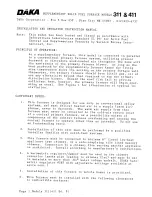
DO NOT bottom out gas valve regulator adjusting screw.
This can result in unregulated manifold pressure and result in
excess overfire and heat exchanger failures.
NOTE:
If orifice hole appears damaged or it is suspected to have
been redrilled, check orifice hole with a numbered drill bit of
correct size. Never redrill an orifice. A burr-free and squarely
aligned orifice hole is essential for proper flame characteristics.
e. Move setup switch SW-2 to OFF position after completing
low-heat adjustment.
f. Jumper R and W2 thermostat connections on control center.
(See Fig. 10.) This keeps furnace locked in high-heat
operation.
g. Turn high-heat adjusting screw (5/64 hex Allen wrench)
counterclockwise (out) to decrease input rate or clockwise
(in) to increase rate.
NOTE:
DO NOT set high-heat manifold pressure less than 3.2-in.
wc or more than 3.8-in. wc for natural gas. If manifold pressure is
outside this range, change main burner orifices.
h. When correct input is obtained, replace caps that conceal
gas valve regulator adjustment screws. Main burner flame
should be clear blue, almost transparent. (See Fig. 16.)
i. Remove jumper R to W2.
4. Verify natural gas input rate by clocking gas meter.
a. Calculate high-altitude adjustment (if required).
UNITED STATES
At altitudes above 2000 ft, this furnace has been approved
for a 4 percent derate for each 1000 ft above sea level. See
Table 8 for derate multiplier factor and example.
EXAMPLE:
80,000 Btuh input furnace installed at 4300 ft.
Furnace Input
Rate at
Sea Level
X
Derate
Multiplier
Factor
=
Furnace Input Rate
at Installation
Altitude
80,000
X
0.82
=
65,600
CANADA
At installation altitudes from 2000 to 4500 ft, this furnace
must be derated 10 percent by an authorized Gas Conver-
sion Station or Dealer. To determine correct input rate for
altitude, see example above and use 0.82 as derate multi-
plier factor.
b. Check that gas valve adjustment caps are in place for
proper input to be clocked.
c. Obtain yearly heat value average for local gas supply.
NOTE:
Be sure heating value of gas used for calculations is
correct for your altitude. Consult local gas utility for altitude
adjustment of gas heating value.
d. Check and verify orifice size in furnace. NEVER AS-
SUME THE ORIFICE SIZE. ALWAYS CHECK AND
VERIFY.
e. Turn off all other gas appliances and pilots.
f. Move setup switch SW-2 to ON position. (See Fig. 13.)
This keeps furnace locked in low-heat operation.
g. Jumper R to W/W1.
h. Let furnace run for 3 minutes in low-heat operation.
i. Measure time (in sec) for gas meter to complete 1 revolu-
tion. Note reading.
j. Refer to Table 10 for cubic ft of gas per hr.
k. Multiply gas rate cu ft/hr by heating value (Btu/cu ft).
l. Move setup switch SW-2 to OFF position and jumper R and
W2 thermostat connections. (See Fig. 13.) This keeps
furnace locked in high-heat operation. Repeat items h
through k for high-heat operation.
DO NOT redrill orifices. Improper drilling (burrs, out-of-
round holes, etc.) can cause excessive burner noise and
misdirection of burner flames. This can result in flame
impingement of burners and heat exchangers, causing
failures.
A93059
BURNER
ORIFICE
Table 8—Altitude Derate Multiplier for U.S.A.
ALTITUDE
(FT)
% OF
DERATE
DERATE MULTIPLIER
FACTOR FOR U.S.A.*
0—2000
0
1.00
2001—3000
8—12
0.90
3001—4000
12—16
0.86
4001—5000
16—20
0.82
5001—6000
20—24
0.78
6001—7000
24—28
0.74
7001—8000
18—32
0.70
8001—9000
32—36
0.66
9001—10,000
36—40
0.62
* Derate multiplier factor is based on midpoint altitude for altitude range.
16









































